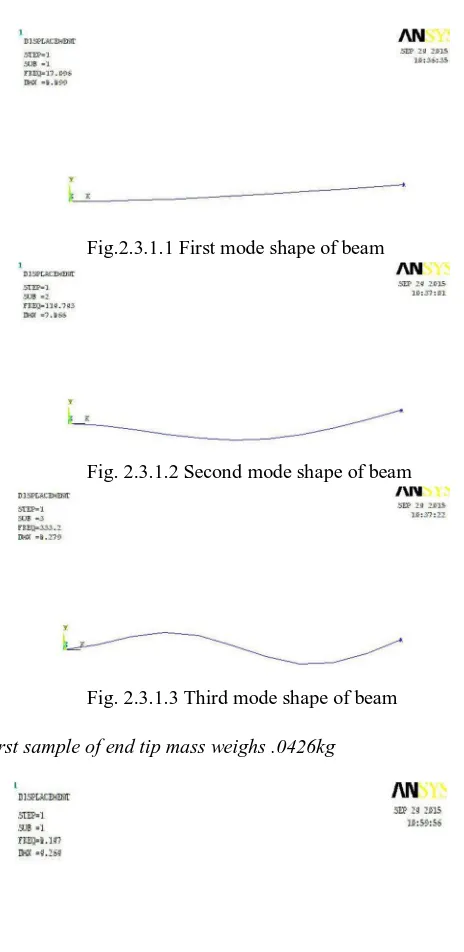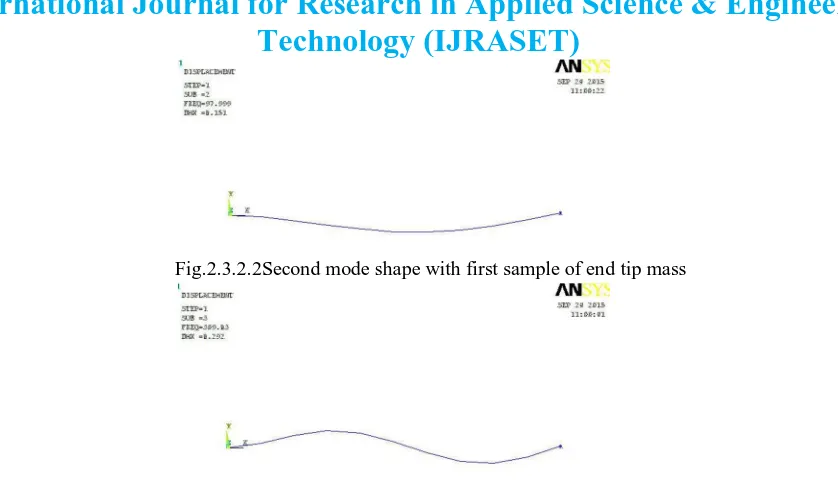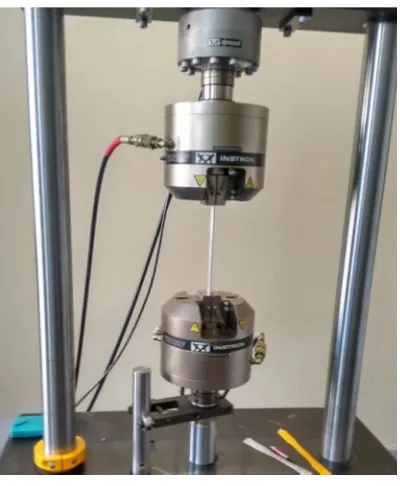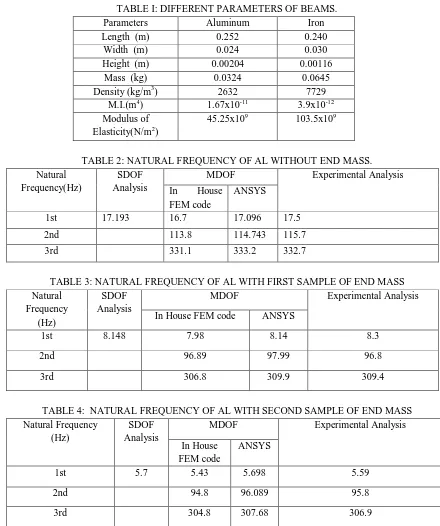Technology (IJRASET)
Vibration Analysis of Cantilever Beam: An
Experimental Study
Mr. P.Kumar1, Dr. S.Bhaduri2, Dr. A. Kumar3
1-3
Department of Mechanical Engineering, Birla Institute of Technology Mesra, Jharkhand, India
Abstract-- The purpose of this study is to investigate the natural frequencies of a cantilever beam experimentally and validate the result with finite element analysis of the beam. The finite element analysis is performed in MATLAB programming and the output from the program is validated with the analysis of the beam in ANSYS. The free vibration response of the beam with lumped end mass subjected to an initial disturbance is also studied in this paper. Different end masses are attached at the free end of the beam to study the influences of these masses on the natural frequencies of the beam. The values of material parameters i.e. density and modulus of elasticity etc considered during experiment are measured experimentally in the testing lab. This experimental setup can be used to measure the natural frequencies of any cantilever beam whose material properties are unknown.
Keywords- Natural frequency, Cantilever beam, mass, vibration.
I. INTRODUCTION
Cantilever beam is considered as one of the most fundamental structure in the field of structural mechanics. Cantilevers are widely found in construction mainly in bridges and balconies. Detection of the natural frequencies of the structure is considered as the most important observation in the vibration analysis as it is needed to avoid resonant condition. Therefore so many studies have been carried out previously to detect the natural frequencies of the cantilever beam. All the parameters which are the main agent to affect the natural frequencies of cantilever beam are needed to be considered. One of such parameter for small and slender structure of cantilever beam is mass of an accelerometer itself that affects the exact measured natural frequency values. It is found that the mass of an accelerometer affects the natural frequencies according to its location and the ratio of its mass to the mass of beam.
Hamdan and Jubran [1] have closely studied the modal analysis of cantilever beam with translational restraint due to spring at the tip end and an intermediate position of additional mass. The free and forced response has been studied by Galerkin’s method.
Kotambkar [2] have studied the effect of mass attachment on natural frequency of free-free beam using analytical, numerical and experimental investigation. In many situations, the mass of accelerometer is ignored, however when lighter structures are investigated this effect must be count.
Liu and Haung [3] studied free vibration of beam. The beam was hinged by a rotational spring at one end and carried a concentrated mass at arbitrary location. For vibration analysis of beam Laplace Transformation method was used.
Wang [4] proposed the vibration analysis of uniform beam with lumped mass in both translational and rotary inertias condition. Finite element analysis is used to form expression of frequency for different attached location of lumped mass.
Kaunadis [5] analyzed the vibration analysis of cantilever beam in free and forced condition. The cantilever beam was loaded at different locations.
Technology (IJRASET)
II. ANALYSISA. SDOF model analysis
The governing equation for free undamped vibration of single degree of freedom (SDOF) system is given by,
mӱ +ky =0 ….. (1)
ӱ + y =0
ω = ….. (2)
Where
ω= Natural frequency of system in rad/s
m =Mass of beam in kg
k =Stiffness of the system in N/m.
The stiffness of a cantilever beam at the free end of the beam is k = …… (3)
Where
E =Young's modulus of the beam in N/m2
l =Total length of beam in m.
I =Moment of inertia of the beam cross section given by
I = m4
Where
b = breadth of the beam cross section
d = width of the beam cross section
Case 1: Calculation of natural frequency of Cantilever beams without end mass
From equation 1
ω = rad/s =1/2П Hz ...… (4)
m = mac +mb
Where
Technology (IJRASET)
=4.69 gm=.00469Kg (measured)
mb= is the equivalent lumped mass of the beam at the free end of the beam, where M=mass of total beam
Case 2: Calculation of natural frequency of Cantilever beams with end tip mass
With end tip mass me the value of mass for the system is equal to
m =mac +mb+ me
Now the value of natural frequency can be found with the help of eq. (4)
B. M.D.O.F Analysis of the cantilever beam
In a multi-degree of freedom (MDOF) model of the beam let the
n
1
vector
X
contains the displacements of the beam at its degrees of freedom. If the mass, stiffness and damping matrices of sizesn
n
are represented by the symbols
M
,
K
and
C
respectively, the governing equation of free vibration of motion for the system can be written as follows:-
M
X
C
X
K
X
{
0
}
………. (1a) in state space notations,
X
X
I
K
M
C
M
X
X
0
1 1 ..(2a)Or,
Z
A
Z
……….. (2b)The mass, stiffness matrices of the beam elements are given below which are assembled to form the overall mass and stiffness matrices.
[K]=Element stiffness matrix
=
12 6 −12 6 6 4 −6 2
−12 −6 12 −6 6 2 −6 4
[m]=Element mass matrix
=
⎣ ⎢ ⎢ ⎢
⎡15622 224 1354 − −313
54 13 156 −22
−13 −3 −22 4
⎦ ⎥ ⎥ ⎥ ⎤
The Eigen values of [A] matrix will give the natural frequencies of the beam.
C. Analysis of beams through ansys
Technology (IJRASET)
is also done for iron beam.
1) Analysis of aluminum without mass
[image:5.612.177.409.134.610.2]The three mode shapes obtained of aluminium beam from ANSYS is shown below.
Fig.2.3.1.1 First mode shape of beam
Fig. 2.3.1.2 Second mode shape of beam
Fig. 2.3.1.3 Third mode shape of beam
2) Analysis of aluminium with first sample of end tip mass weighs .0426kg
Technology (IJRASET)
[image:6.612.97.516.47.296.2]Fig.2.3.2.2Second mode shape with first sample of end tip mass
Fig. 2.3.2.3 Third mode shape with first sample of end tip mass
3) Analysis of aluminium beam with second sample of end tip mass weighs .100kg
[image:6.612.180.445.343.603.2]Fig.2.3.3.1First mode shape with second sample of end tip mass
Fig.2.3.3.2Second mode shape with second sample of end tip mass
Technology (IJRASET)
D. Analysis of beams through experiment
[image:7.612.103.469.197.399.2]All the material properties of the beam and the dimensions are measured in the lab. Fig 2.4.1 shows the experimental set up of a complete UTM machine in which the young modulus of the material is measured experimentally. Two slender, elastic beams of aluminum and iron are considered for frequency analysis. The lengths of beams are measured by ruler scale; whereas width and height are measured by electronic gauge. The masses of beams and mass of accelerometer are measured by the weighing machine
Fig. 2.4.1 UTM Machine with all accessories
Fig. 2.4.2 Close view of specimen testing.
The main parts of UTM machine is shown in Fig 2.4.1. The beam specimen is fixed in between two jaw faces with the help of
Main Machine Interface (MMI)
Control Panel
10 Ton Capacity Load cell with Jaw face
Computer System
[image:7.612.187.387.433.676.2]Technology (IJRASET)
remote guide (Fig 2.4.2). The UTM machine applies force on specimen by two of its jaw tangentially. The power application of jaw is guided hydraulically by power pack and chiller oil pulling (not shown in fig.). The whole setup is controlled by control panel which give instruction to MMI which further connected with computer system to provide required value on its screen.
The fig.2.4.3 shows the experimental setup of for the analysis of natural frequency of beam with accelerometer sensor. The setup also consists of FFT analyzer with computer and its accessories. For further analysis of the effect of different masses on the natural frequency of cantilever beam, free end of cantilever is loaded with different masses along with accelerometer and the result of this experiment is observed on the computer screen for the aluminium and iron beams. The setup can be used to analyze any cantilever beams with different masses to measure their natural frequencies.
Figure2.4.3: Experimental set up
The output shown on computer screen after analysis with and without end tip masses for aluminium beam is shown below.
Fig.2.4.4: Output of FFT analyzer for aluminium beam with no tip mass attached at free end of cantilever beam
The same analysis is also done for iron beam with same experimental setup.
III. NUMERICAL STUDY
Cantilever with accelerometer and end mass
Exciting hammer
FFT Analyzer
Technology (IJRASET)
and the cross section is 30X 1.16 mm2. The length of the aluminium cantilever beam is 252 mm and the cross section is 24X 2.04 mm2. All the dimensions and material properties of the beams are listed below in Table 1. The first three natural frequencies are calculated for the above mentioned beams using finite element analysis with and without the presences of the end mass. The finite element analysis is done using the developed codes in MATLAB and also by ANSYS software. Using the above mentioned experimental setup the natural frequencies of the beams are measured experimentally with and without the presence of the end mass. The analytical and the experimental results of the natural frequencies for the above mentioned beams are tabulated below. Table 2 to 7 shows the value of natural frequencies of Al and Fe beam obtained analytically and experimentally with and without end tip masses (mass of accelerometer is also considered).
TABLE I: DIFFERENT PARAMETERS OF BEAMS. Parameters Aluminum Iron Length (m) 0.252 0.240
Width (m) 0.024 0.030 Height (m) 0.00204 0.00116
Mass (kg) 0.0324 0.0645 Density (kg/m3) 2632 7729
M.I.(m4) 1.67x10-11 3.9x10-12 Modulus of
Elasticity(N/m2)
45.25x109 103.5x109
TABLE 2: NATURAL FREQUENCY OF AL WITHOUT END MASS. Natural
Frequency(Hz)
SDOF Analysis
MDOF Experimental Analysis In House
FEM code
ANSYS
1st 17.193 16.7 17.096 17.5
2nd 113.8 114.743 115.7
3rd 331.1 333.2 332.7
TABLE 3: NATURAL FREQUENCY OF AL WITH FIRST SAMPLE OF END MASS Natural
Frequency (Hz)
SDOF Analysis
MDOF Experimental Analysis In House FEM code ANSYS
1st 8.148 7.98 8.14 8.3
2nd 96.89 97.99 96.8
[image:9.612.79.519.193.719.2]3rd 306.8 309.9 309.4
TABLE 4: NATURAL FREQUENCY OF AL WITH SECOND SAMPLE OF END MASS Natural Frequency
(Hz)
SDOF Analysis
MDOF Experimental Analysis In House
FEM code
ANSYS
1st 5.7 5.43 5.698 5.59
2nd 94.8 96.089 95.8
Technology (IJRASET)
TABLE 5: NATURAL FREQUENCY OF FE WITHOUT END MASS. Natural Frequency
(Hz)
SDOF Analysis
MDOF Experimental Analysis In House FEM
code
ANSYS
1st 10.6 9.96 10.47 10.5
2nd 66.3 67.216 66.9
3rd 190.2 191.257 192.5
TABLE 6: NATURAL FREQUENCY OF FE WITH FIRST SAMPLE OF END MASS Natural
Frequency (Hz)
SDOF Analysis MDOF Experimental Analysis In House FEM
code
ANSYS
1st 5.958 5.678 5.955 6.2
2nd 54.67 55.887 56.5
[image:10.612.97.513.348.451.2]3rd 172.9 173.394 173.6
TABLE 7: NATURAL FREQUENCY OF FE WITH SECOND SAMPLE OF END MASS
Natural Frequency
(Hz)
SDOF Analysis
MDOF Experimental Analysis In House FEM
code
ANSYS
1st 4.32 4.09 4.302 4.45
2nd 53.4 54.027 53.8
3rd 169.8 171.2 170.9
IV. CONCLUSION
In this study the natural frequencies of the beams are measured experimentally. The finite element analysis of the beam is done using the developed codes in MATLAB and in ANSYS software. It is very much clear that there is a very close agreement between the experimental and analytical values. The accelerometer is used here to measure the vibration parameters. It is placed at the free end of the beam. The mass of the accelerometer is considered in the analysis and the effect of end tip mass on natural frequencies is also studied in this paper. It is observed experimentally as well as analytically that the higher values of end mass will lower the natural frequency of the beam.
V. ACKNOWLEDGMENTS
All the experiments of this study were conducted in the Central Instrumentation Facility (CIF) Lab of BIT, Mesra, Ranchi and the results obtained from those experimental set up were compared with the finite element analysis. The photographs of the
experimental setup (fig.no.2.4.1, 2.4.2, 2.4.3) are taken in CIF Lab.
REFERENCES
[1] M.N.Hamdan and B.A.Jubran “Free and Forced Vibration of a Restrained Cantilever Beam Carrying Concentrated Mass,”Eng.Sci,Vol.3,pp-71-83-1991. [2] M.S. Kotambar, “Effect of Mass Attachment on Natural Frequency of Fee-Free Beam: Analytical, Numerical and Experimental Investigation,”International
Journal of Advanced Engineering research and studies E-ISSN2249-8974.
[3] Liu,W.H,and Haung,C.C, “Free Vibration of Restrained Beam Carrying Concentrated Masses,”Journal of Sound and Vibration,123:31-42(1988).




